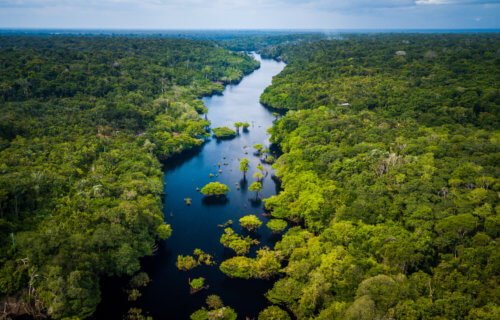EXETER, United Kingdom — The Amazon rainforest may be close to falling off an environmental cliff, a new study warns. Researchers from the University of Exeter have discovered that the famous South American rainforest has lost most of its resilience in recent years — making it more likely the Amazon could die out and never return.
Since the early 2000s, study authors say over three-quarters of the rainforest has lost its resilience. This is a measure of the Amazon’s ability to recover from damaging events like fires and droughts. The study warns that the Amazon appears to be reaching a concerning tipping point. If it crosses that threshold, the rainforest could suffer from widespread dieback and turn into a savanna — like Africa, India, and northern Australia. Dieback refers to a tree starting to die at the tip of its leaves or roots and moving backwards.
“The Amazon rainforest is a highly complex system, so it’s very difficult to predict if and when a tipping point could be reached,” says Dr. Chris Boulton of Exeter’s Global Systems Institute, in a university release. “We now have satellite data on the Amazon that covers a sufficiently long timespan to observe changes in resilience. Our study looked in detail at month-to-month changes as the forest responded to fluctuating weather conditions.”
“We studied metrics that are theoretically related to the rate of recovery after perturbations (external events that affect the forest), to see how the resilience of the Amazon ecosystem has changed in recent decades,” Dr. Boulton continues.
“Resilience dropped during the major droughts of 2005 and 2010, as part of an ongoing decline from the early 2000s to the most recent data in 2016. As a result, we would expect the forest to recover more slowly from a drought now than it would have twenty years ago.”

What’s destroying the Amazon’s resilience?
Researchers note that the Amazon actually became more resilient to natural disasters between 1991 and 2000. However, the rainforest’s recent loses since then has dropped its resilience to levels even lower than they were at the start of the 90s.
“Deforestation and climate change are likely to be the main drivers of this decline,” explains Professor Niklas Boers from the Potsdam Institute for Climate Impact Research (PIK) and the Technical University of Munich.
“Resilience is being lost faster in parts of the rainforest that are closer to human activity, as well as those with less rainfall. Many researchers have theorized that a tipping point could be reached, but our study provides vital empirical evidence that we are approaching that threshold.”

(CREDIT: TiPES/HP)
You may not see a change, but it’s still happening
Study authors note that a lot of what’s happening over the last 20 years may not be visible to the naked eye. Although climate change continues to impact the planet, the study finds average rainfall levels in the Amazon are roughly the same over the last few decades. What is changing, however, is the severity and length of droughts in the area.
The team also points out there’s a big difference between the Amazon visibly losing trees and the region losing its resilience to grow them back.
“The rainforest can look more or less the same, yet it can be losing resilience – making it slower to recover from a major event like a drought,” says Professor Tim Lenton, the director of Exeter’s Global Systems Institute.
“If too much resilience is lost, dieback may become inevitable – but that won’t become obvious until the major event that tips the system over,” adds Prof. Boers. “Many interlinked factors – including droughts, fires, deforestation, degradation and climate change – could combine to reduce resilience and trigger the crossing of a tipping point in the Amazon.”
“This gives new compelling evidence to support efforts to reverse deforestation and degradation of the Amazon to give it back some resilience against ongoing climate change,” Lenton concludes.
The study is published in the journal Nature Climate Change.
